Ijraset Journal For Research in Applied Science and Engineering Technology
- Home / Ijraset
- On This Page
- Abstract
- Introduction
- Conclusion
- References
- Copyright
Result Analysis of User Review for Sentiment Classification
Authors: Miss. Rutuja P. Bhende, Prof. T. R. Mahore, Dr. R. R. Keole
DOI Link: https://doi.org/10.22214/ijraset.2022.45827
Certificate: View Certificate
Abstract
Analysis of Sentiment is one of the fastest growing fields with its demand and potential benefits that are increasing each and every day. Analysis of Sentiment aims to classify the polarity of a document by using the natural language processing, text analysis. by using of internet and modern technology, there has been a lot of growth in the amount of data. Each and every individual is in position to precise his/her own ideas freely on social media. Every data can be analyzed and used in order to draw benefits and quality information. In this paper, the focus is on cyber-hate classification based on for public opinion or views, since the spread of hate speech using social media can have disruptive impacts on social sentiment analysis. In recent , here proposing a modified approach with two stage training for dealing with text ambiguity and classifying three type approach positive, negative and neutral sentiment, and compare its performance with those popular methods and also some existing fuzzy approaches. After that comparing to the performance of proposed work with commonly used sentiment classifiers which are known to perform well in this task. The results indicate that our modified approach performs marginally better than the other algorithms.
Introduction
I. INTRODUCTION
In world internet is growing bigger, its horizons are becoming wider. Platform of Social Media and Micro blogging platforms such as Facebook, Twitter, Tumblr dominate in spreading news and trending topics across the globe at a rapid pace. A topic becomes more famous if more and more users are contributing their opinion and judgments, thereby making it a valuable source of online perception [1]. These topics spread awareness or to market public figures, political campaigns during elections, product endorsements and entertainment like product, award shows. Big organizations and firms cash in of people's feedback to enhance their products and services which further help in enhancing marketing strategies. It is help to function an application to understand the attitudes, opinions and emotions expressed within an web mention. The main purpose is to realize an summary of the broader popular opinion behind certain topics. Precisely, it is a paradigm of categorizing conversations into three labels such as positive, negative or neutral labels. Most of the people use a platform of social media sites for networking with other people and to stay up- to-date with current news and current events. Our sites (Twitter, Facebook, Instagram) offer a platform to people to voice their opinions. For example , if people quickly post their reviews online as soon as they watch a product and then start a series of comments to discuss about the acting skills depicted in the product. This types of information forms a basis for people to evaluate, feedback about the performance of not only any product but also about other similar products and to know about check whether it will be a success or not. This Kind of vast information on these sites can useful for marketing and social studies [2].Due to the , sentiment analysis has wide applications and includes emotion mining, polarity, classification and influence analysis. Twitter is an another online networking site driven by tweets which produces millions of tweet each and every day. Usually, these steams of raw twitter data comprises of irregular, noisy, poor structured sentence, ill formed, incomplete words, non dictionary terms, and irregular expressions is not in structured manner. Twitter sentiment analysis uses of natural language processing to extract, identify to characterize the sentiment content. At the time of analysis of tweets expressed in not an easy job. Most of the challenges are involved in terms of tonality, polarity, lexicon and grammar of the tweets. They used to be highly unstructured and non-grammatical. It gets more difficult to interpret their meaning. Large usage of slang words, acronyms and word ambiguity are quite common while tweeting online. The differentiation of such reviews into specific class polarity gets tough for natural processors involved. Our paper, focus is on the detection of online hate speech (cyber hate) in text posted to social media platforms on the basis of four types such as of online hate speech, namely, religion, race, disability, and sexual orientation, by proposing a completely unique approach, especially for handling with text ambiguity.
The rest of this paper is structured as follows. In Section II, we detailed some related work of our project by highlighting important features. Next, Section III gives brief details about the proposed system. Section IV covers details of methodology & implementation of the project. The result and analysis part are specified in section V. Further, in Section VI, future work and conclusion is discussed.
II. RELATEDWORK
Our paper “Analysis of Sentiment for twitter published in 2012 describe a machine learning approach to implement sentiment analysis on the data. [3] They used performed sentiment classification of Twitter data where the classes are positive label, negative label and neutral label. Two types of models are utilized: Tree part and highlight based models and every models beat the unigram pattern. For the element based approach they used the examination, Which uncovers that the foremost critical components are people who that join the sooner extremity of words and their parts of discourse labels[4].
In “The Twitter for Analysis of Sentiment: The Bad the great and The OMG” paper, they used explored the utility of phonetic components for recognizing the assumption of twitter messages [5][6]. They already known the value of existing of lexical assets and extras includes that catch data about the casual and imaginative dialect utilized as a neighborhood of varied social sites. An approach has been introduced to unravel the issues.
In Our Paper “The Twitter Sentiment Classification using Discrete Supervision” published in 2009 describe novel approach for naturally grouping the sensation of varied twitter message [5]. These messages are either describe because the positive or negative with reference to the information. The paper classified the preprocessing of varied steps so as to realize very high accuracy. The principle commitment of our paper is to utilizing tweets with emoticons for much off regulated learning Diverse machine learning classifiers and highlight extractors have been utilized alongside the utilization of unigrams, bigrams, unigrams and bigrams, and parts of discourse as components.
III. PROPOSED SYSTEM
A. Process of DSA and Cyber Hat
In proposed system there are basically two types modules are available. First module of the system indicate dual sentiment analysis (DSA) framework intimately. And second module of the system indicate the prediction user review rating on user previously review data.Fig. 3.1 illustrates the method of a dual sentiment analysis. In this fig, the rectangle crammed with slash denotes the original data and the rectangle filled with backslash denotes the reversed data. DSA contains two main stages: dual training (DT) and dual prediction (DP).
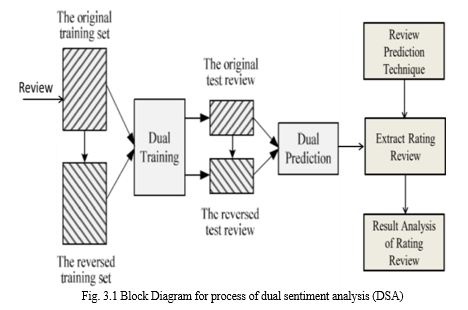
B. Dual Training(DT)
The original training specimens are used they are reversed to their opposites. Informs to them as “original training set” and “reversed training set”. In our data expansion technique, there’s a one-to-one correspondence among the original and reversed reviews. The classifier is trained by maximizing a mixture of the likelihoods of the original and reversed training samples. This process is named dual training.
C. Dual Prediction (DP)
Dual prediction works in addressing the polarity shift problem. This point think” I don’t like this book. It’s boring” is an ingenious test review, and “I like this book. It is interesting” is the reversed test review.
D. Review Prediction Technique
In review paper users predict the reviews like positive and negative. This collection of reviews used for various opinion analysis tasks. Users give the reviews on product online. The admin then checks reviews of uploaded product, and displays a web rating for each product
E. Extract Rating Review
After gives the user online reviews, system extract the reviews like positive, negative and neutral. Then it displays as web rating reviews and extracting from the positive, negative and neutral reviews.
F. Result Analysis of Rating Review
In the result analysis, all the reviews are gathers for a specific product and calculate the amount of count for positive- negative-neutral. This Positive-negative neutral count is generated the graphically view of positive-negative neutral analysis. These systems also sorts and display the analysis and calculate the result. This provides an automatic product rating review system supported on sentiment analysis.
IV. METHODOLOGY AND IMPLEMENTATION
Usually encounter product rating websites where users are allowed to review on products online. These rating are provided as input to the web site admin. The admin then checks reviews and displays an web rating for every product. Here propose an online system that automatically allows users to post reviews and store them. The system now analyzes this data to check for user sentiments associated with each review. Our system consists of a sentiment library. The system breaks user review to see for sentiment keywords. Once the keywords are shown it associates the review with a sentiment rank. The system now gathers all review for a particular product and then calculates the positive-negative-neutral count. This provides an automatic product rating system supported on sentiment analysis.
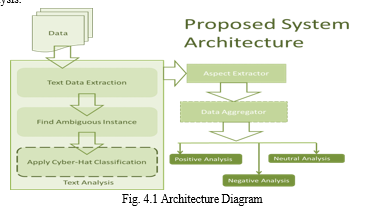
- Review Rating and Analysis: The system further processes sentiment ratings and then analysis for a particular product.
- Graphical Analysis: The system displays graphically positive-negative-neutral product reviews.
V. RESULT ANALYSIS
In this system, user gives the reviews like positive, negative and neutral. This collection of reviews used for various opinion analysis tasks. Users give the reviews on products online. The admin then checks reviews, and displays an online rating for every product. Usually encounter product rating websites where users are allowed to review on products online. These rating are provided as input to the web site admin. The admin then checks reviews and displays an online rating for each product. Online system that automatically allows users to post reviews and store them.
In the result analysis, first calculate the amount of positive-negative-neutral count then on the basis of counting, it represents the graphically. The system now analyzes this data to check for user sentiments associated with each review. The system now gathers all review for a specific product and then calculates the amount of count for the positive-negative-neutral. This provides an automatic product rating system based on sentiment analysis.
In result analysis, first show the Review analysis table and then graphical analysis with the assistance of particular product.
- Product 1: Mi Note 4
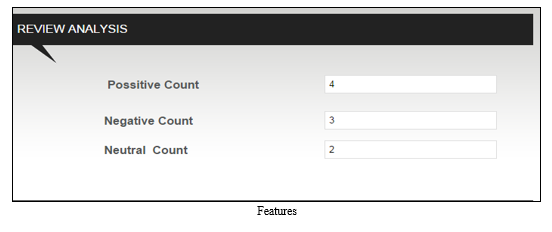
Table 4.1(a) Review Analysis
- User Registration/ Login: Users may login to system and register if not already registered.
- Reviews: Users may reviews on a product provided within the system.
- Review Storage: The system stores each review for further processing.
- Sentiment Analysis: The system process reviews for finding out sentiments and their weightage.
- Single review Count: One user can review just one occasion for a specific product.
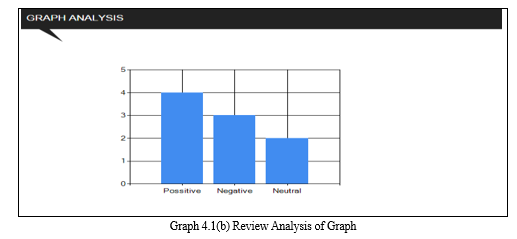
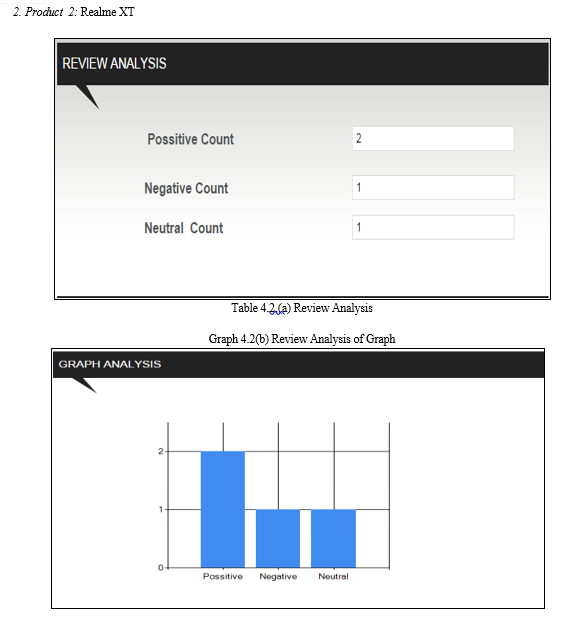 ???????
???????
Conclusion
A. Conclusion Sentiment Analysis is extremely important research because Sentiment Analysis helps in summarizing opinion and reviews of public. They consider as research filed. However, Sentiment Analysis still needs to improve and progress. Moreover, there are many challenges just like the polarity during a sentence. In this paper, specialize in creating reversed reviews to assist supervised sentiment classification. DSA is highlighted by the technique of one-to-one correspondence data expansion and therefore the manner of using a pair of samples in training (dual training) and prediction (dual prediction). Then highlights the essential ideas about Sentiment Analysis and then explains in details the Sentiment Classification and Technique. B. Future Scope In the future scope, can expand the DSA and cyber hat algorithm to a bigger range of sentiment analysis tasks. And consider also an idea for more complex polarity shift patterns such as transitional, subjunctive and sentiment- inconsistent sentences in creating reversed reviews.
References
Communication and Automation (ICCCA), pp.12-18, 2016. [2] Dr. Khalid N. Alhayyan& Dr. Imran Ahmad “Discovering and Analyzing Important Real-Time Trends in Noisy Twitter Stream”, SYSTECS, CYBERNETICS AND INFORMATICS, VOLUME 15 - NUMBER 2 - YEAR 2017, pp. 25-31. [3] The David Haussler, D.C. Uthus and D. W. Aha. “Plans toward automated chat summarization”. In Meeting of the Association for Computational Linguistics, pp.1–7,2011. [4] M Hu and B Liu. 2004,” The Mining of data and summarizing the customer reviews based on an issue”. KDD \'04: Proceedingsof the tenth ACM SIGKDD international conference onKnowledge discovery and data mining, pp. 168–17, August 2004.. [5] S M Kim and E Hovy, ”Determining the sentimental analysis of various opinions”, Proceedings of the COLING conference, Geneva, pp. 1-8,2004. [6] Erumit, A.K.Nabiyev, V. Cebi, A.Karadeniz Tech. University, Trabzon, Turkey, “The Design of motion problems based on The graphical theory in counting the number of words in math”, Turkey,pp.68-81,2006. [7] Agarwal, B. Xie, I. Vovsha, O. Rambow, and R. Passonneau, “Sentiment analysis of Twitter data,” in Proc. Workshop Lang. Social Media, Stroudsburg, PA, USA, pp. 30–38,Jun 2016. [8] N. Pendar, “Toward spotting the pedophile telling victim from predator in text chats,” in Proc. International Conference Semantic Computer., Irvine, CA, USA, pp. 235–241, Sep.2007. [9] K. Thiel and M. Berthold, “The KNIME text processing feature: An introduction,” KNIME, Zürich, Switzerland, Tech. Rep. 120403F, 2, pp.1-27, 2012. [10] M.-C. De Marneffe, B. MacCartney, and C. D. Manning, “Generating typed dependency parses from phrase structure parses,” in Proc. 5th International.Conference. Language Resource Eval., Genoa, Italy, pp. 71–80,May 2006. [11] V. Tursi and R. Silipo , “From Words to Wisdom- An Introduction to Text Mining With KNIME”. Zurich, Switzerland: KNIME Press,2018. [12] N. Djuric, J. Zhou, R. Morris, M. Grbovic, V. Radosavljevic, and N. Bhamidipati, “Hate speech detection with comment embeddings,” in Proc. 24th Int. Conf. World Wide Web, pp. 29– 30,May2015. [13] Nemes, “Regulating hate speech in cyberspace: Issues of desirability and ef?cacy,” J. Inf. Communication Technical.
Copyright
Copyright © 2022 Miss. Rutuja P. Bhende, Prof. T. R. Mahore, Dr. R. R. Keole. This is an open access article distributed under the Creative Commons Attribution License, which permits unrestricted use, distribution, and reproduction in any medium, provided the original work is properly cited.

Download Paper
Paper Id : IJRASET45827
Publish Date : 2022-07-20
ISSN : 2321-9653
Publisher Name : IJRASET
DOI Link : Click Here
 Submit Paper Online
Submit Paper Online

